Part 3: Set Up PostfixAdmin Virtual Mailboxes on Debian Mail Server (PostgreSQL)
In previous articles, we discussed how to set up your own mail server on Debian from scratch. In part 1 and part 2 of this tutorial series, we learned how to set up Postfix SMTP server and Dovecot IMAP server, but so far we can only have email addresses for users with local Unix accounts. This tutorial is going to show you how to create virtual mailboxes on Debian mail server with PostfixAdmin, which is an open-source web-based interface to configure and manage a Postfix-based email server for many domains and users.
With virtual mailboxes, we don’t need to create a local Unix account for each email address. If you are going to set up a mail server for a company or organization, it’s always better to have an easy way to create virtual mailboxes in a web-based interface, which also allows users to change their passwords. That’s where PostfixAdmin comes in.
PostfixAdmin Features
- Manage mailboxes, virtual domains, and aliases
- Vacation/out-of-office messages (Personally I think it’s better done in Roundcube webmail)
- Alias domains (forwarding one domain to another with recipient validation)
- Users can manage their own mailbox (change alias, password and vacation message)
- Quota support for single mailboxes and total quota of a domain
- Fetchmail integration: You can fetch emails from your original email address to your new email address.
- Command-line client postfixadmin-cli for those who don’t want to click around in a web interface 😉
Notice
- This tutorial works on Debian 11 Bullseye and Debian 10 Buster.
- Once you finish part 3, you can no longer use local Unix accounts as email addresses. You must create email addresses from the PostfixAdmin web interface.
- This tutorial will show you how to install PostfixAdmin with the PostgreSQL database server. If you prefer to install PostfixAdmin with MariaDB/MySQL database server, please follow this Postfixadmin/MariaDB tutorial.
Requirements
It’s required that you have followed part 1 and part 2 of this tutorial series before continuing to read this article. If you followed mail server tutorials published by other websites, I recommend purging your current configurations (sudo apt purge postfix dovecot-core) and start over with my tutorial series, so you are not going to be confused by different setup processes.
Once the above requirements are met, let’s install and configure PostfixAdmin.
Step 1: Install PostgreSQL Database Server
PostfixAdmin is written in PHP and requires a database (MySQL/MariaDB, PostgreSQL, or SQLite). This article will use the PostgreSQL database. Enter the following command to install PostgreSQL on Debian.
sudo apt install postgresql postgresql-contrib
After it’s installed, PostgreSQL database server will automatically start and listens on 127.0.0.1:5432, as can be shown with:
sudo ss -lnpt | grep 5432
Sample output:
LISTEN 0 244 127.0.0.1:5432 0.0.0.0:* users:(("postgres",pid=24074,fd=5))
If you don’t see any output in the command line window, then PostgreSQL isn’t running. Start it with this command:
sudo systemctl start postgresql
To enable PostgreSQL to automatically start at boot time, run
sudo systemctl enable postgresql
If it still refuses to start, you need to check the log file under /var/log/postgresql/ to find out what went wrong.
Step 2: Download PostfixAdmin on Debian Server
PostfixAdmin is included in the default Debian repository. However, I don’t recommend it for the following reasons:
- It can create problems when you upgrade the Debian system to a new version, resulting in upgrade failure.
- If you use Nginx, the
postfixadminpackage might automatically install Apache on your system. - If you use MySQL, this package might remove MySQL from your system.
- The default
postfixadminpackage has a login loop issue from time to time.
So I will show you how to install the latest version of PostfixAdmin. Go to PostfixAdmin Gitbub page to download the latest version. You can use the wget tool to download it from command line. The download link is always available in the format below. If a new version comes out, simply replace 3.3.11 with the new version number.
sudo apt install wget
wget https://github.com/postfixadmin/postfixadmin/archive/postfixadmin-3.3.11.tar.gz
Once downloaded, extract the archive to the /var/www/ directory and rename it to postfixadmin.
sudo mkdir -p /var/www/ sudo tar xvf postfixadmin-3.3.11.tar.gz -C /var/www/ sudo mv /var/www/postfixadmin-postfixadmin-3.3.11 /var/www/postfixadmin
Step 3: Setting Up Permissions
PostfixAdmin requires a templates_c directory, and the web server needs read and write access to this directory, so run the following commands.
sudo mkdir -p /var/www/postfixadmin/templates_c sudo apt install acl sudo setfacl -R -m u:www-data:rwx /var/www/postfixadmin/templates_c/
Starting with Dovecot 2.3.11, the web server user (www-data) needs permission to read Let’s Encrypt TLS certificate in order to do password hashing. Run the following two commands to grant permissions.
sudo setfacl -R -m u:www-data:rx /etc/letsencrypt/live/ /etc/letsencrypt/archive/
Step 4: Create a Database and User for PostfixAdmin
Log into PostgreSQL as the postgres user.
sudo -u postgres psql
Create the postfixadmin database. I named it postfixadmin, but you can use whatever name you like. (Don’t leave out the semicolon.)
CREATE DATABASE postfixadmin;
Create a database user (postfixadmin) and set a password. Replace postfixadmin_password with your preferred password. Note that the password should not contain the # character, or you might not be able to log in later.
CREATE USER postfixadmin WITH PASSWORD 'postfixadmin_password';
Grant permissions to the database user.
ALTER DATABASE postfixadmin OWNER TO postfixadmin; GRANT ALL PRIVILEGES ON DATABASE postfixadmin TO postfixadmin;
Press Ctrl+D to log out of the PostgreSQL console.
Then run the following command to test if you can log in to PostgreSQL as postfixadmin user.
psql -h 127.0.0.1 -d postfixadmin -U postfixadmin -W
Press Ctrl+D to log out.
Step 5: Configure PostfixAdmin
The default PostfixAdmin configuration file is config.inc.php. We need to create a config.local.php file and add custom configurations.
sudo nano /var/www/postfixadmin/config.local.php
Add the following lines in the file, so PostfixAdmin can connect to PostgreSQL database. Replace postfixadmin_password with the real PostfixAdmin password created in step 4.
<?php
$CONF['configured'] = true;
$CONF['database_type'] = 'pgsql';
$CONF['database_host'] = 'localhost';
$CONF['database_port'] = '5432';
$CONF['database_user'] = 'postfixadmin';
$CONF['database_password'] = 'postfixadmin_password';
$CONF['database_name'] = 'postfixadmin';
$CONF['encrypt'] = 'dovecot:ARGON2I';
$CONF['dovecotpw'] = "/usr/bin/doveadm pw -r 5";
if(@file_exists('/usr/bin/doveadm')) { // @ to silence openbase_dir stuff; see https://github.com/postfixadmin/postfixadmin/issues/171
$CONF['dovecotpw'] = "/usr/bin/doveadm pw -r 5"; # debian
}
Save and close the file. Note that we will use the ARGON2I password scheme. By default, PostfixAdmin and Dovecot use MD5-CRYPT, which is a weak password scheme. You can list available password schemes in Dovecot with the following command.
sudo doveadm pw -l
Sample output:
SHA1 SSHA512 BLF-CRYPT PLAIN HMAC-MD5 OTP SHA512 SHA RPA DES-CRYPT CRYPT SSHA MD5-CRYPT SKEY PLAIN-MD4 PLAIN-MD5 SCRAM-SHA-1 LANMAN SHA512-CRYPT CLEAR CLEARTEXT ARGON2I ARGON2ID SSHA256 NTLM MD5 PBKDF2 SHA256 CRAM-MD5 PLAIN-TRUNC SHA256-CRYPT SMD5 DIGEST-MD5 LDAP-MD5
Step 6: Create Apache Virtual Host or Nginx Config File for PostfixAdmin
Apache
If you use Apache web server, create a virtual host for PostfixAdmin.
sudo nano /etc/apache2/sites-available/postfixadmin.conf
Put the following text into the file. Replace postfixadmin.example.com with your real domain name and don’t forget to set DNS A record for it.
<VirtualHost *:80>
ServerName postfixadmin.example.com
DocumentRoot /var/www/postfixadmin/public
ErrorLog ${APACHE_LOG_DIR}/postfixadmin_error.log
CustomLog ${APACHE_LOG_DIR}/postfixadmin_access.log combined
<Directory />
Options FollowSymLinks
AllowOverride All
</Directory>
<Directory /usr/share/postfixadmin/>
Options FollowSymLinks MultiViews
AllowOverride All
Order allow,deny
allow from all
</Directory>
</VirtualHost>
Save and close the file. Then enable this virtual host with:
sudo a2ensite postfixadmin.conf
Reload Apache for the changes to take effect.
sudo systemctl reload apache2
Now you should be able to see the PostfixAdmin web-based install wizard at http://postfixadmin.example.com/setup.php.
Nginx
If you use Nginx web server, create a virtual host for PostfixAdmin.
sudo nano /etc/nginx/conf.d/postfixadmin.conf
Put the following text into the file. Replace postfixadmin.example.com with your real domain name and don’t forget to set DNS A record for it.
server {
listen 80;
listen [::]:80;
server_name postfixadmin.example.com;
root /var/www/postfixadmin/public/;
index index.php index.html;
access_log /var/log/nginx/postfixadmin_access.log;
error_log /var/log/nginx/postfixadmin_error.log;
location / {
try_files $uri $uri/ /index.php;
}
location ~ ^/(.+\.php)$ {
try_files $uri =404;
fastcgi_pass unix:/run/php/php8.1-fpm.sock;
fastcgi_index index.php;
fastcgi_param SCRIPT_FILENAME $document_root$fastcgi_script_name;
include /etc/nginx/fastcgi_params;
}
}
Save and close the file. Then test Nginx configuration.
sudo nginx -t
If the test is successful, reload Nginx for the changes to take effect.
sudo systemctl reload nginx
Now you should be able to see the PostfixAdmin web-based install wizard at http://postfixadmin.example.com/setup.php.
Step 7: Install Required and Recommended PHP Modules
Run the following command to install PHP modules required or recommended by PostfixAdmin.
curl -sSL https://packages.sury.org/php/README.txt | sudo bash -x sudo apt update sudo apt install php8.1-fpm php8.1-imap php8.1-mbstring php8.1-pgsql php8.1-curl php8.1-zip php8.1-xml php8.1-bz2 php8.1-intl php8.1-gmp php8.1-redis
If you use Apache, you also need to install the libapache2-mod-php package.
sudo apt install libapache2-mod-php
Then restart Apache.
sudo systemctl restart apache2
Step 8: Enabling HTTPS
To encrypt the HTTP traffic, we can enable HTTPS by installing a free TLS certificate issued from Let’s Encrypt. Run the following command to install Let’s Encrypt client (certbot) on Debian 22.04 server.
sudo apt install certbot
If you use Apache, install the Certbot Apache plugin.
sudo apt install python3-certbot-apache
And run this command to obtain and install TLS certificate.
sudo certbot --apache --agree-tos --redirect --hsts --staple-ocsp --email you@example.com -d postfixadmin.example.com
If you use Nginx, then you also need to install the Certbot Nginx plugin.
sudo apt install python3-certbot-nginx
Next, run the following command to obtain and install TLS certificate.
sudo certbot --nginx --agree-tos --redirect --hsts --staple-ocsp --email you@example.com -d postfixadmin.example.com
Where
--nginx: Use the nginx plugin.--apache: Use the Apache plugin.--agree-tos: Agree to terms of service.--redirect: Force HTTPS by 301 redirect.--hsts: Add the Strict-Transport-Security header to every HTTP response. Forcing browser to always use TLS for the domain. Defends against SSL/TLS Stripping.--staple-ocsp: Enables OCSP Stapling. A valid OCSP response is stapled to the certificate that the server offers during TLS.
The certificate should now be obtained and automatically installed, which is indicated by the message below.
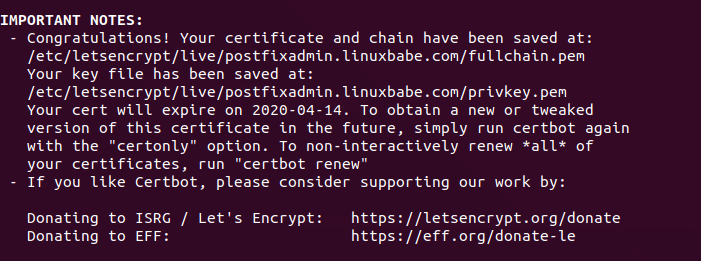
Step 9: Enable Statistics in Dovecot
PostfixAdmin needs to read Dovecot statistics. Edit the Dovecot configuration file.
sudo nano /etc/dovecot/conf.d/10-master.conf
Add the following lines to the end of this file.
service stats {
unix_listener stats-reader {
user = www-data
group = www-data
mode = 0660
}
unix_listener stats-writer {
user = www-data
group = www-data
mode = 0660
}
}
Save and close the file. Then add the web server to the dovecot group.
sudo gpasswd -a www-data dovecot
Restart Dovecot.
sudo systemctl restart dovecot
Grant permissions to the www-data user.
sudo setfacl -R -m u:www-data:rwx /var/run/dovecot/stats-reader /var/run/dovecot/stats-writer
Step 10: Launch the Web-Based Setup Wizard
Go to postfixadmin.example.com/setup.php to run the web-based setup wizard. First, you need to create a setup password for PostfixAdmin.
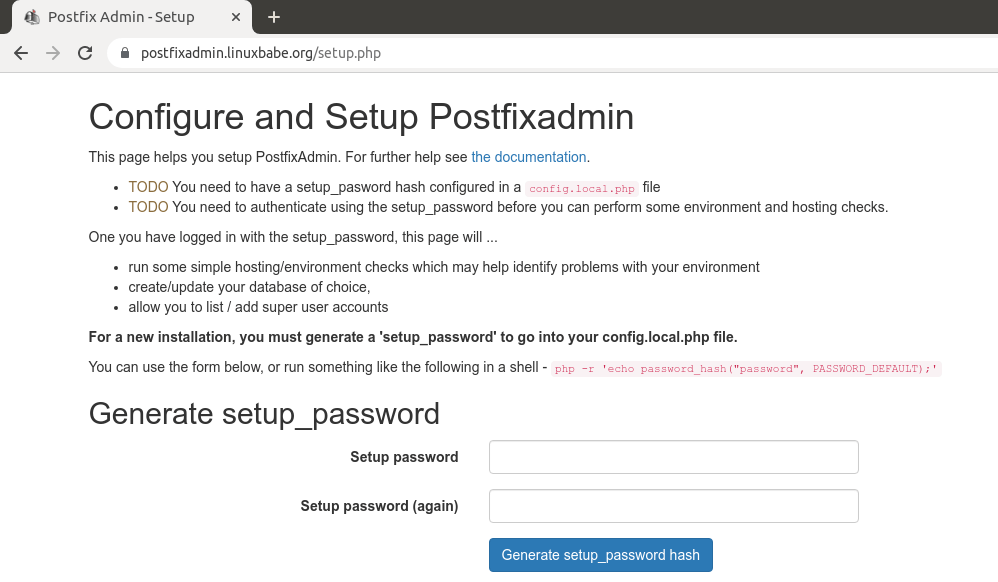
After creating the password hash, PostfixAdmin will display a line like below.
$CONF['setup_password'] = '$2y$10$58fIawuOb5y538RMBol/DOoqv2bJ7zhPRzRO.4Xq7MLeQJHmaFwF2';
You need to open the config.local.php file.
sudo nano /var/www/postfixadmin/config.local.php
Add the line displayed on PostfixAdmin setup page to the end of the file like below.
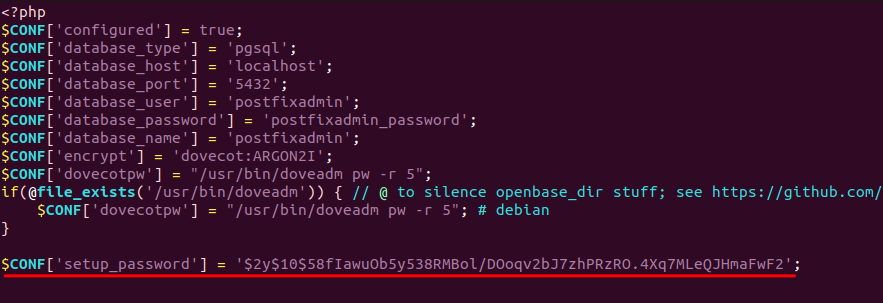
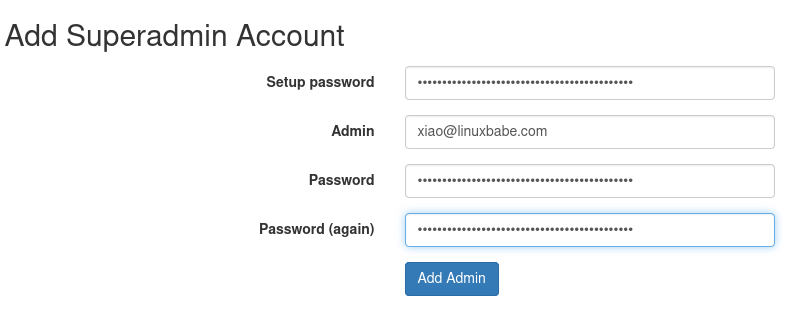
If you see the following error when trying to create a superadmin account,
Password Hashing - attempted to use configured encrypt backend (dovecot:ARGON2I) triggered an error: /usr/bin/doveadm pw -r 5 failed, see error log for details
It’s because the www-data user doesn’t have permission to read Let’s Encrypt TLS certificate. To fix it, run the following command to grant permissions.
sudo setfacl -R -m u:www-data:rx /etc/letsencrypt/live/ /etc/letsencrypt/archive/
Sometimes, you might also need to run the following command to fix this error.
sudo setfacl -R -m u:www-data:rwx /var/run/dovecot/stats-reader /var/run/dovecot/stats-writer
Once the superadmin account is created, you can log into PostfixAdmin at postfixadmin.example.com/login.php.
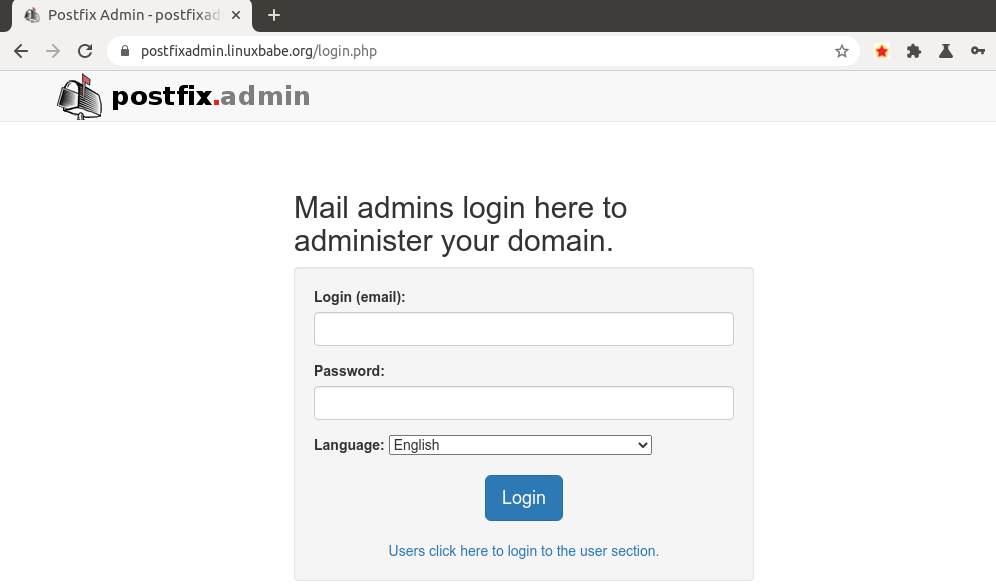
Step 11: Checking Tables in the Database
The PostfixAdmin setup process populates the postfixadmin database with some default tables. It’s helpful for us to know the names and structure of the tables. Log in to PostgreSQL console.
sudo -u postgres psql
Select the postfixadmin database.
\c postfixadmin;
List all tables in this database.
\dt;
Output:
List of relations Schema | Name | Type | Owner --------+-----------------------+-------+-------------- public | admin | table | postfixadmin public | alias | table | postfixadmin public | alias_domain | table | postfixadmin public | config | table | postfixadmin public | domain | table | postfixadmin public | domain_admins | table | postfixadmin public | fetchmail | table | postfixadmin public | log | table | postfixadmin public | mailbox | table | postfixadmin public | quota | table | postfixadmin public | quota2 | table | postfixadmin public | vacation | table | postfixadmin public | vacation_notification | table | postfixadmin (13 rows)
The 3 most important tables are:
domain: contains information on the domains that are using your mail server to send and receive email.mailbox: contains information on every email address, including hashed password and the location of mail files.alias: contains the alias of each email address.
If you are interested, you can check what columns each table contains. For example, the following command will show us the columns in the domain table.
\d domain;
Output:
Table "public.domain"
Column | Type | Collation | Nullable | Default
-----------------+--------------------------+-----------+----------+-------------------------
domain | character varying(255) | | not null |
description | character varying(255) | | not null | ''::character varying
aliases | integer | | not null | 0
mailboxes | integer | | not null | 0
maxquota | bigint | | not null | 0
quota | bigint | | not null | 0
transport | character varying(255) | | | NULL::character varying
backupmx | boolean | | not null | false
created | timestamp with time zone | | | now()
modified | timestamp with time zone | | | now()
active | boolean | | not null | true
password_expiry | integer | | | 0
Indexes:
"domain_key" PRIMARY KEY, btree (domain)
"domain_domain_active" btree (domain, active)
Log out of PostgreSQL console.
\q
Step 12: Configure Postfix to Use PostgreSQL Database
By default, Postfix delivers emails only to users with a local Unix account. To make it deliver emails to virtual users whose information is stored in the database, we need to configure Postfix to use virtual mailbox domains.
First, we need to add PostgreSQL map support for Postfix by installing the postfix-pgsql package.
sudo apt install postfix-pgsql
Then edit the Postfix main configuration file.
sudo nano /etc/postfix/main.cf
Add the following lines at the end of this file.
virtual_mailbox_domains = proxy:pgsql:/etc/postfix/pgsql/virtual_domains_maps.cf virtual_mailbox_maps = proxy:pgsql:/etc/postfix/pgsql/virtual_mailbox_maps.cf virtual_alias_maps = proxy:pgsql:/etc/postfix/pgsql/virtual_alias_maps.cf relay_domains = $mydestination, proxy:pgsql:/etc/postfix/pgsql/relay_domains.cf
Where:
virtual_mailbox_domainspoints to a file that will tell Postfix how to look up domain information from the database.virtual_mailbox_mapspoints to files that will tell Postfix how to look up email addresses from the database.virtual_alias_mapspoints to files that will tell Postfix how to look up aliases from the database.
We want to use dovecot to deliver incoming emails to the virtual users’ message store, so also add the following line at the end of this file.
virtual_transport = lmtp:unix:private/dovecot-lmtp
Save and close the file. Next, we need to create the .cf files one by one. Create the pgsql directory.
sudo mkdir -p /etc/postfix/pgsql/
Create the virtual_domains_maps.cf file.
sudo nano /etc/postfix/pgsql/virtual_domains_maps.cf
Add the following content. Replace postfixadmin_password with the postfixadmin database password you set in step 4.
user = postfixadmin
password = postfixadmin_password
hosts = localhost
dbname = postfixadmin
#query = SELECT domain FROM domain WHERE domain='%s' AND active = true
#optional query to use when relaying for backup MX
query = SELECT domain FROM domain WHERE domain='%s' and backupmx = false and active = true
Create the virtual_mailbox_maps.cf file.
sudo nano /etc/postfix/pgsql/virtual_mailbox_maps.cf
Add the following content.
user = postfixadmin
password = postfixadmin_password
hosts = localhost
dbname = postfixadmin
query = SELECT maildir FROM mailbox WHERE username='%s' AND active = true
Create the virtual_alias_maps.cf file.
sudo nano /etc/postfix/pgsql/virtual_alias_maps.cf
Add the following content.
user = postfixadmin
password = postfixadmin_password
hosts = localhost
dbname = postfixadmin
query = SELECT goto FROM alias WHERE address='%s' AND active = true
Create the relay_domains.cf file.
sudo nano /etc/postfix/pgsql/relay_domains.cf
Add the following content.
user = postfixadmin
password = postfixadmin_password
hosts = localhost
dbname = postfixadmin
query = SELECT domain FROM domain WHERE domain='%s' and backupmx = true
Since the database passwords are stored in plain text so they should be readable only by user postfix and root, which is done by executing the following two commands.
sudo chmod 0640 /etc/postfix/pgsql/* sudo setfacl -R -m u:postfix:rx /etc/postfix/pgsql/
Next, we need to change the value of the mydestination parameter in Postfix. Display the current value:
sudo postconf mydestination
Sample output:
mydestination = $myhostname, linuxbabe.com, localhost.$mydomain, localhost
The mydestination parameter contains a list of domain names that will receive emails delivered to local Unix accounts. In part 1, we added the apex domain name (like linuxbabe.com) to mydestination. Since we are going to use virtual mailbox, we need to remove the apex domain name from the list by issuing the following command.
sudo postconf -e "mydestination = \$myhostname, localhost.\$mydomain, localhost"
Now let’s open the Postfix main configuration file again.
sudo nano /etc/postfix/main.cf
Add the following lines at the end of this file.
virtual_mailbox_base = /var/vmail virtual_minimum_uid = 2000 virtual_uid_maps = static:2000 virtual_gid_maps = static:2000
The first line defines the base location of mail files. The remaining 3 lines define which user ID and group ID Postfix will use when delivering incoming emails to the mailbox. We use the user ID 2000 and group ID 2000.
Save and close the file. Restart Postfix for the changes to take effect.
sudo systemctl restart postfix
Next, we need to create a user named vmail with ID 2000 and a group with ID 2000.
sudo adduser vmail --system --group --uid 2000 --disabled-login --no-create-home
Create the mail base location.
sudo mkdir -p /var/vmail/
Make vmail as the owner.
sudo chown vmail:vmail /var/vmail/ -R
Step 13: Configure Dovecot to Use PostgreSQL Database
We also need to configure the Dovecot IMAP server to query user information from the database. First, run the following command to add PostgreSQL support for Dovecot.
sudo apt install dovecot-pgsql
Then edit the 10-mail.conf file.
sudo nano /etc/dovecot/conf.d/10-mail.conf
In part 2, we used the following mail_location. Email messages are stored under the Maildir directory under each user’s home directory.
mail_location = maildir:~/Maildir
Since we are using virtual mailbox domain now, we need to enable mail_home for the virtual users by adding the following line in the file, because virtual users don’t have home directories by default.
mail_home = /var/vmail/%d/%n/
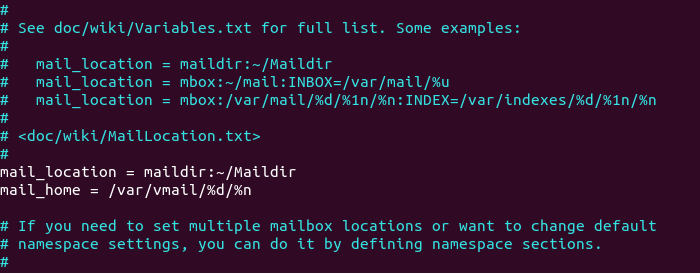
Save and close the file. Then edit the 10-auth.conf file.
sudo nano /etc/dovecot/conf.d/10-auth.conf
In part 2, we used the following value for auth_username_format.
auth_username_format = %n
The %n would drop the domain if it was given. Because in part 2 we were using local Unix account for the username of every email address, we must use %n to drop the domain, so users were able to login with the full email address.
Now we are using virtual mailbox domains, which means the username of every email address includes the domain part, so we need to change the auth_username_format as follows. %u won’t drop away the domain. This allows users to login with the full email address.
auth_username_format = %u
Then find the following line.
#auth_default_realm =
Change it to
auth_default_realm = example.com
This is to ensure users who didn’t enter the @example.com part in the username field can still log in. Dovecot will append the @example.com part if it’s not given by users.
Next, uncomment the following line at the end of this file, so Dovecot can query user information from PostgreSQL database.
!include auth-sql.conf.ext
Now you probably don’t want local Unix users to send emails without registering email addresses in PostfixAdmin, then comment out the following line by adding the # character at the beginning, so Dovecot won’t query the local /etc/passwd or /etc/shadow file.
#!include auth-system.conf.ext
It can be helpful to add the following two lines in this file to debug login issues. The login errors would be logged into /var/log/mail.log file. (Once users can login without problems, you can comment out the following two lines.)
auth_debug = yes auth_debug_passwords = yes
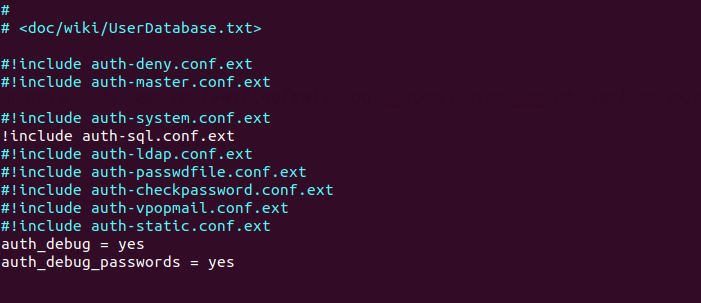
Save and close the file.
Edit the dovecot-sql.conf.ext file.
sudo nano /etc/dovecot/dovecot-sql.conf.ext
Here is the content that you should have in this file. By default, all lines in this file are commented out, so you can simply copy and paste them at the bottom. Replace postfixpassword with the postfixadmin password you set in Step 4.
driver = pgsql
connect = host=localhost dbname=postfixadmin user=postfixadmin password=postfixadmin_assword
default_pass_scheme = ARGON2I
password_query = SELECT username AS user,password FROM mailbox WHERE username = '%u' AND active = true
user_query = SELECT maildir, 2000 AS uid, 2000 AS gid FROM mailbox WHERE username = '%u' AND active = true
iterate_query = SELECT username AS user FROM mailbox
Restart Dovecot.
sudo systemctl restart dovecot
When a user tries to log in, Dovecot would use the Argon2 algorithm to generate a password hash from the password entered by the user, then compare it with the password hash stored in the database.
Step 14: Add Domain and Mailboxes in PostfixAdmin
Log in to PostfixAdmin web interface as the admin. Click the Domain List tab and select New Domain to add a domain. You can choose how many aliases and mailboxes are allowed for this domain.
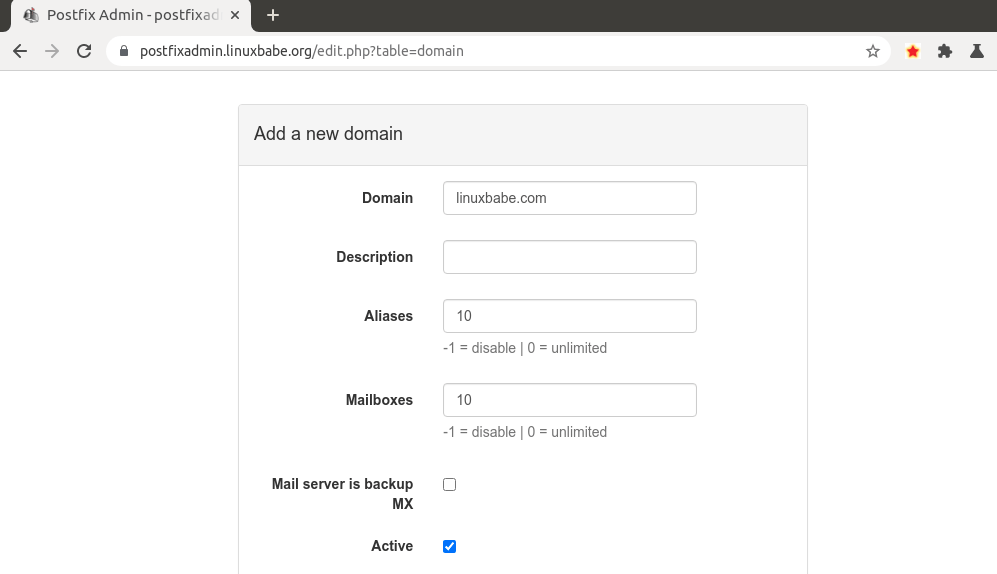
Then click Virtual List tab and select Add Mailbox to add a new email address for your domain.
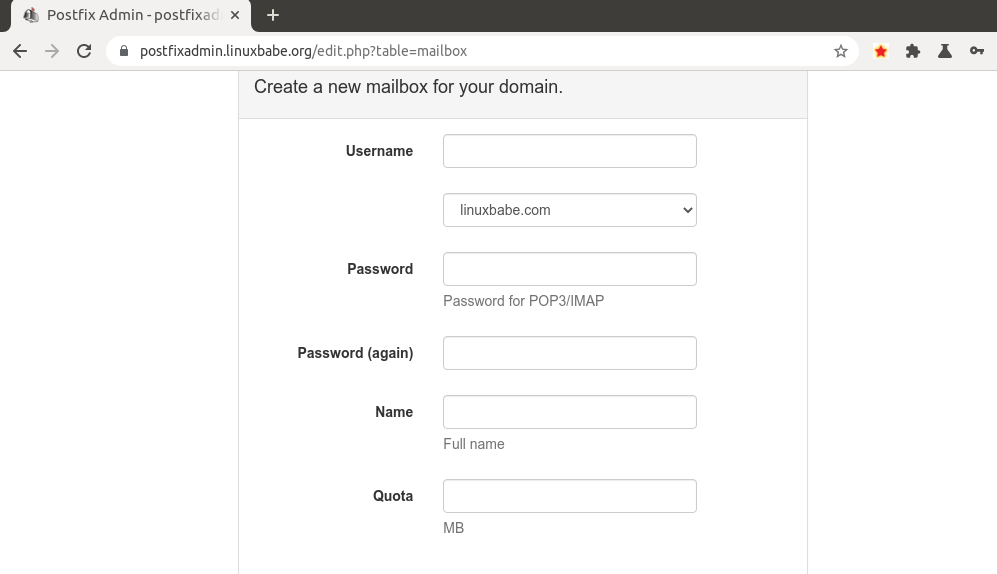
Next, you can open your desktop email client such as Mozilla Thunderbird and add a mail account.
- In the incoming server section, select IMAP protocol, enter
mail.your-domain.comas the server name, choose port 143 and STARTTLS. Choosenormal passwordas the authentication method. - In the outgoing section, select SMTP protocol, enter
mail.your-domain.comas the server name, choose port 587 and STARTTLS. Choosenormal passwordas the authentication method.
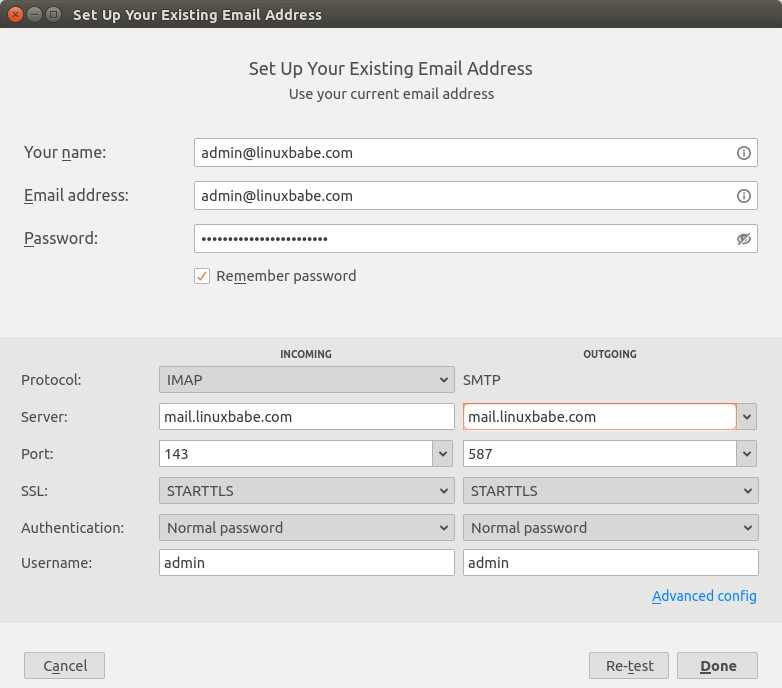
Hint: You can also use port 993 with SSL/TLS encryption for IMAP, and use port 465 with SSL/TLS encryption for SMTP. You should not use port 25 as the SMTP port in mail clients to submit outgoing emails.
You should now be able to connect to your own email server and also send and receive emails with your desktop email client! Note that you cannot use local Unix accounts to login now. You must log in with the virtual user created from PostfixAdmin web interface.
Troubleshooting Tips
As a rule of thumb, you should always check the mail log (/var/log/mail.log) on your mail server when an error happens. The following is a list of specific errors and troubleshooting tips.
Can’t login from Mail Clients
If you can’t log into your mail server from a desktop mail client, scan your mail server to find if the ports are open. Note that you should run the following command from another Linux computer or server. If you run it on your mail server, then the ports will always appear to be open.
sudo nmap mail.your-domain.com
And check if Dovecot is running.
systemctl status dovecot
You can also check the mail log (/var/log/mail.log), which may give you some clues. If Dovecot fails to start, the error might not be logged to the /var/log/mail.log file, you can run the following command to see what’s wrong.
sudo journalctl -eu dovecot
If you see the following error in the mail log, it’s likely that you didn’t set a correct password in the .cf files under /etc/postfix/sql/ directory.
postfix/trivial-rewrite[28494]: warning: virtual_alias_domains: proxy:pgsql:/etc/postfix/sql/pgsql_virtual_alias_maps.cf: table lookup problem postfix/trivial-rewrite[28494]: warning: virtual_alias_domains lookup failure
If you see the following error in the mail log, it’s because you forgot to add mail_location = maildir:~/Maildir in the /etc/dovecot/conf.d/10-mail.conf file.
open(/var/mail/username@domain.com) failed: Permission denied (euid=2000(vmail) egid=2000(vmail) missing +w perm: /var/mail, we're not in group 8(mail), dir owned by 0:8 mode=0775
Cloudflare DNS
As I said in part 1, if you use Cloudflare DNS service, you should not enable the CDN (proxy) feature when creating DNS A record and AAAA record for the hostname of your mail server. Cloudflare doesn’t support SMTP or IMAP proxy.
Relay Access Denied
If you see the “relay access denied” error when trying to send emails from a mail client, it’s most likely that you use port 25 as the SMTP port in your mail client. As I said a while ago, you should use port 587 or 465 as the SMTP port in mail clients (Mozilla Thunberbird, Microsoft Outlook, etc) to submit outgoing emails. Port 25 should be used for SMTP server to SMTP server communications.

Connection Lost to Authentication Server
If you can’t send emails from a mail client, and you find the following line in the mail log (/var/log/mail.log), it might be that your email server is too slow and Dovecot takes more than 10 seconds to authenticate the user. Postfix times out at 10 seconds and drops the connection.
SASL PLAIN authentication failed: Connection lost to authentication server
You can avoid SASL connection timeout by enabling the submission service in Dovecot, so we can get rid of the submission service in Postfix and there won’t be SASL connection timeout.
First, edit Postfix master configuration file.
sudo nano /etc/postfix/master.cf
Disable the submission service in Postfix by commenting out the following lines.
#submission inet n - y - - smtpd # -o syslog_name=postfix/submission # -o smtpd_tls_security_level=encrypt # -o smtpd_tls_wrappermode=no # -o smtpd_sasl_auth_enable=yes # -o smtpd_relay_restrictions=permit_sasl_authenticated,reject # -o smtpd_recipient_restrictions=permit_mynetworks,permit_sasl_authenticated,reject # -o smtpd_sasl_type=dovecot # -o smtpd_sasl_path=private/auth
Save and close the file. Then restart Postfix.
sudo systemctl restart postfix
Next, install the Dovecot submission daemon.
sudo apt install dovecot-submissiond
Edit Dovecot main configuration file.
sudo nano /etc/dovecot/dovecot.conf
Enable the submission protocol.
protocols = imap lmtp submission
Then add the following lines at the end of this file. This tells Dovecot to relay the submitted email to Postfix SMTP server, so the email can be sent out.
submission_relay_host = 127.0.0.1 submission_relay_port= 25 submission_relay_trusted = yes submission_relay_ssl = no
Save and close the file. Restart Dovecot.
sudo systemctl restart dovecot
Now check what process is listening on TCP port 587.
sudo ss -lnpt | grep 587
If everything is working, you should see that Dovecot is listening on port 587.
LISTEN 0 100 0.0.0.0:587 0.0.0.0:* users:(("dovecot",pid=71047,fd=16)) LISTEN 0 100 [::]:587 [::]:* users:(("dovecot",pid=71047,fd=17))
Now you should be able to send emails from a mail client like Thunberbird.
iOS Mail App
If you use the iOS Mail app to log into your mail server and encounter the following error.
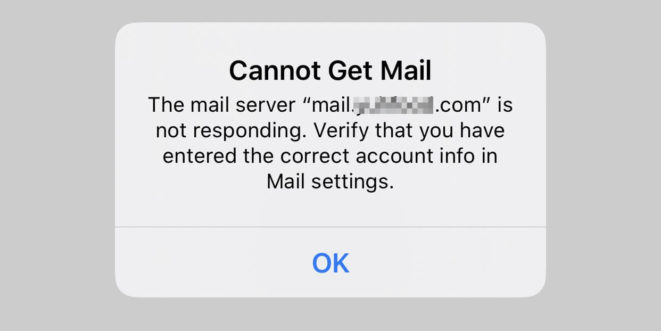
You can try to fix it by enforcing SSL encryption, for both SMTP and IMAP.
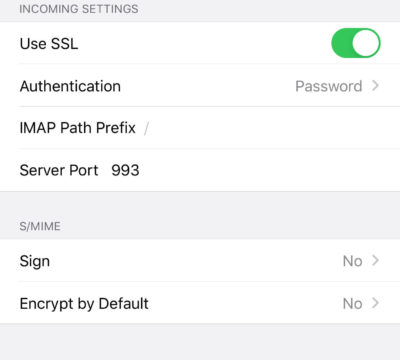
Fun fact: It seems the iOS Mail app has difficulty in supporting STARTTLS on IMAP port 143, but it supports STARTTLS on the submission port 587.
Temporary Lookup Failure
If your mail server was working fine for some time, but suddenly you find the following error in the mail log,
Aug 25 20:25:24 mx postfix/trivial-rewrite[3313]: warning: virtual_alias_domains: proxy:pgsql:/etc/postfix/sql/pgsql_virtual_alias_maps.cf: table lookup problem Aug 25 20:25:24 mx postfix/trivial-rewrite[3313]: warning: virtual_alias_domains lookup failure Aug 25 20:25:24 mx postfix/submission/smtpd[3464]: NOQUEUE: reject: 451 4.3.0 <user@your-domain.com>: Temporary lookup failure; proto=ESMTP Aug 25 20:25:24 mx postfix/submission/smtpd[3464]: Temporary lookup failure
Thunderbird may also complain of a temporary lookup failure.
Sending of the message failed. An error occurred while sending mail. The mail server responded: <sombody@gmail.com>: Temporary lookup failure. Please check the message recipient somebody@gmail.com and try again.
It’s likely that your PostgreSQL database stopped somehow. You can use the following command to check when your database server stopped.
sudo journalctl -eu postgresql
A common cause for this situation is that your server is out-of-memory. Check if your server has enough memory.
htop
or
free -m
Sometimes it might be that the Postfix database lookup config files in /etc/postfix/pgsql/ direcotry are wrong somehow like a typo in the password that prevents Postfix from looking up information in the PostgreSQL database.
Automatically Clean the Junk Folder and Trash Folder
To delete emails in Junk folder for all users, you can run
sudo doveadm expunge -A mailbox Junk all
To delete emails in Trash folder, run
sudo doveadm expunge -A mailbox Trash all
I think it’s better to clean emails that have been in the Junk or Trash folder for more than 2 weeks, instead of cleaning all emails.
sudo doveadm expunge -A mailbox Junk savedbefore 2w
Then add a cron job to automate the job.
sudo crontab -e
Add the following line to clean Junk and Trash folder every day.
@daily doveadm expunge -A mailbox Junk savedbefore 2w;doveadm expunge -A mailbox Trash savedbefore 2w
You also need to allow the www-data user to read certificate files by adding the following line.
@daily setfacl -R -m u:www-data:rx /etc/letsencrypt/live/ /etc/letsencrypt/archive/
To receive report when a Cron job produces an error, you can add the following line above all Cron jobs.
MAILTO="you@your-domain.com"
Save and close the file. And you’re done.
Change User Password in PostfixAdmin
Users can log into PostfixAdmin at https://postfixadmin.example.com/users/login.php, then change their passwords.
Restricting Access to Sendmail
By default, any local user can use the sendmail binary to submit outgoing emails. Now that your mail server is using virtual mailboxes, you might want to restrict access to the sendmail binary to trusted local users only, so a malicious user can’t use it to send a large volume of emails to damage your mail server’s reputation. Edit the Postfix main configuration file.
sudo nano /etc/postfix/main.cf
Add the following line to the end of this file, so only the root, www-data, and vmail user can submit emails via sendmail. You can also add other usernames.
authorized_submit_users = root,www-data,vmail
Save and close the file. Then restart Postfix.
sudo systemctl restart postfix
Next Steps
I hope this tutorial helped you install and use PostfixAdmin on Debian to create virtual mailboxes. As always, if you found this post useful, subscribe to our free newsletter to get more tips and tricks.
Now you can follow the remaining parts of this building email server from scratch tutorial series.
- Part 4: Create SPF and DKIM Records to Get Through Spam Filters
- Part 5: Create DMARC Record to Protect Your Domain Reputation
- Part 6: Set Up Roundcube Webmail
- Part 7: 7 Effective Tips to Stop Your Email From Being Marked as Spam
- Part 8: Blocking Email Spam with Postfix
- Part 9: Set Up OpenDMARC to Block Email Spoofing
- Part 10: Blocking Email Spam with SpamAssassin
- Part 11 Set Up Amavis and ClamAV on Debian Mail Server to Scan Virus
- Part 12: How to Secure Email Server Against Hacking with Self-hosted VPN Server
- Part 13: How to Bypass Email Blacklists
- Part 14: Enable and Configure Postscreen in Postfix to Block Spambots
- Part 15: How to Host Multiple Email Domains in PostfixAdmin
Take care 🙂



Muy bueno y complet, gracias, me sirvio de mucho
Hey i am getting these errors and i have no idea what i did wrong. Could u please help me?
Great tutorial so far i am going all the way!!
Leon it’s saying you need to install the database and imap module to connect to the database.
Im using php 8.2 so with me it was apt install php8.2-imap php8.2-pgsql then restart php-fpm with systemctl restart php8.2-fpm